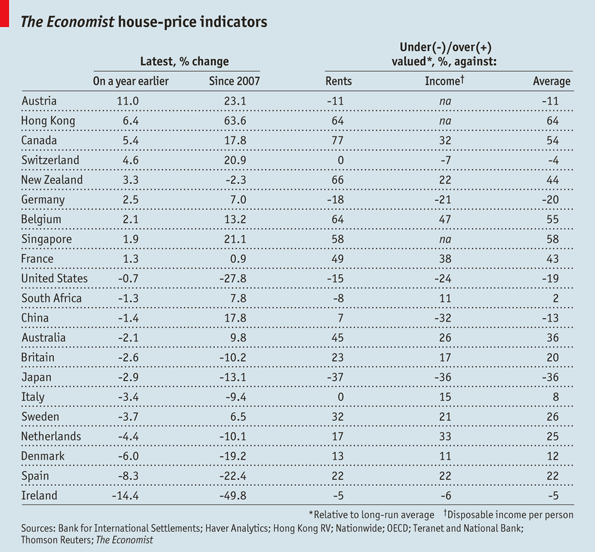The Economist has released its annual assessment of global house prices (one week after my own) and the results are pretty close to my research, showing property is still expensive but improving:

The two components that make up the deviation from fundamental value measure (income and rents) have shifted and the average between them has fallen back from 45% overvalued to 36%, which is good news and similar to my own conclusion of rising (if still troubled) affordability.
In terms of straight price gains over the past decade, Australia is still in the top three:

The full interactive tables are available at The Economist.
As mentioned above, in this week’s edition of Macro Investor I also provided an examination of Australian house price values relative to English-speaking international markets:

Whereas some other housing markets – most notably Ireland, the United States, and the United Kingdom – experienced heavy value losses in the wake of the global financial crisis, Australia’s housing market has remained relatively steadfast, so far avoiding the painful corrections experienced elsewhere.
On its own, however, Australia’s strong house price performance tells us little about the extent to which Australian housing is overvalued, since it does not take into account the growth of incomes and the broader economy over time. It also ignores the returns from housing relative to interest rates and other forms of investment.
One metric commonly used to gauge housing valuations is the Median Multiple, defined as the median dwelling, house or unit price divided by the median household income. RP Data recently released analysis comparing the Median Multiples of Australia’s capital cities across the years 2001, 2005 and 2011. The median house price data came from the RP Data-Rismark database, whereas the median household income was derived from the Census results for those particular years.

According to RP Data, detached house Median Multiples rose by nearly 50% nationally in the 10 years to 2011, with the bulk of this increase occurring between 2001 and 2006. The increases have also not been uniform, with Sydney’s Median Multiple, for example, rising by only 20% over the decade, reflecting the fact that its homes were relatively expensive to begin with.
Comparing Census data on mortgage payments against median household income also confirms that Australian housing has become increasingly expensive over time. For those families with a mortgage, the proportion of average household incomes eaten-up by mortgage payments has increased nationally over the past three Census’, from 26% in 2001 to 34% in 2011. All capitals, with the exception of Sydney, experienced an increased mortgage burden over the five years to 2011.
An examination of Australia’s Median Multiples against those of other English-speaking countries also suggests that Australian homes are expensive by international standards. A chart showing the average Median Multiples of the five largest metropolitan areas in each nation (three largest in New Zealand) is also provided below, which confirms that Australia’s housing is expensive on a price-to-income basis compared with its English-speaking peers.

A similar, albeit less definitive, conclusion is found when the value of the residential housing stock is compared against the gross domestic product (GDP) of each English-speaking nation.
Australia’s ratio of total housing assets to GDP rose by around 50% from the late-1990s on the back of strong house price appreciation that far exceeded growth in the broader economy, peaking at 3.3 times GDP in 2007 and 2010.
Australia’s ratio has since fallen back to around 2.8 times GDP currently, which is similar to New Zealand’s and the United Kingdom’s, but considerably higher than the United States’ and Canada’s.
But, as The Economist points out this week, while Australian homes remain expensive, the combination of declining home prices, lower mortgage rates, and rising incomes has meant that housing affordability has improved significantly in recent years. Australian housing is also becoming more attractive from a value investing perspective, as rents have risen at a faster rate than home prices. Whereas median mortgage payments increased by 38% nationally between the 2006 and 2011 Census’, median rental payments rose by 50%. This is the opposite of what occurred between the 2001 and 2006 Census’, where rental payments rose by 31% compared to 50% growth in mortgage payments over the same period. Similarly, gross rental yields have improved nationally, with house (unit) yields increasing from 4.0% (4.5%) in June 2006 to 4.7% (5.1%) as at June 2012.
Rental returns are also improving for investors purchasing their dwelling outright using savings (i.e. ungeared). Gross rental yields are now in-line with (houses) or slightly above (units) one-year term deposit rates, suggesting that from an income perspective, housing is becoming increasingly attractive when compared against alternative investments. On capital values, however, it remains a steep premium.
Leith van Onselen is the Chief Economist at Macro Investor, Australia’s independent investment newsletter covering stocks, trades, yield and property. This is an excerpt from a special report on Australian housing affordability. It is available as as part of a free 21-day free trial.

